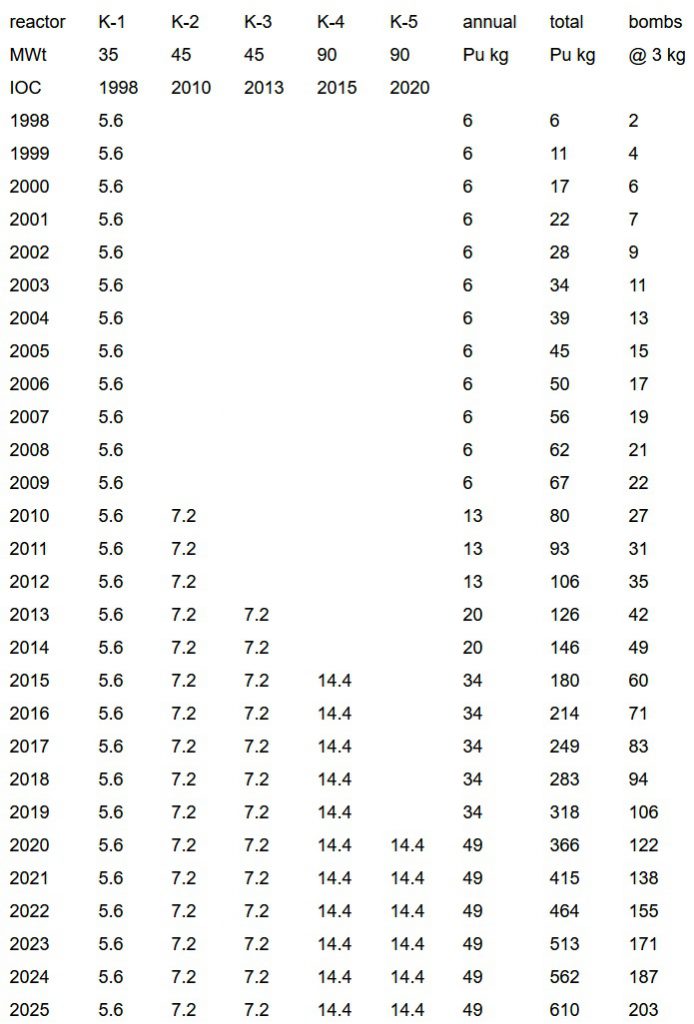Khushab Production Capacity
Pakistan appears poised to bring yet another Plutonium production reactor online in 2020, marking a significant increase in their bomb-making potential. Pakistan’s stockpile of nuclear weapons may already be larger than that of former colonial power United Kingdom. Both have about 200 weapons, more than North Korea [about 100], but fewer than Israel and India [both have about 275 bombs]. While the four reactors at Khushab are well attested, most open source analysis of Pakistan’s program makes little or no mention of the new fifth reactor [as of 23 January 2020, Nuclear Threat Initiative and Arms Control Association did not mention the fifth reactor].
Wikipedia reports “A further reactor has been speculated on (Khushab-V). Space-based surveillance has not turned up signs that work has begun yet on any fifth plutonium reactor at Khushab, although construction of major facilities continues.” In January 2015 ISIS highlighted that new construction activity was taking place in the southwest corner of Pakistan’s Khushab nuclear site, south of reactors 2, 3, and 4. At the time, ISIS speculated that the site could be for another reactor.
Indeed, Google Earth imagery discloses a partially complete reactor, with a configuration generally similar to that of Khushab IV, though with a different orientation. Each of the Khushab reactors has a bank of cooling towers of unique configuration. As is well known, reactor thermal power may be estimated based on the size of these cooling towers [John Pike, Tim Brown and Charles Vick were the first open source analysts to apply this principle, in their work on the Israeli Dimona reactor in the late 1990s]. The devil is in the details, but in round numbers of the area of the fifth reactor cooling towers [ about 14 meters by about 90 meters, yielding a surface area of about 1250 meters2] is about the same as that of the fourth reactor [ about 11 meters by about 110 meters, yielding a surface area of about 1150 meters2]. Both are about twice the size of the early reactors [about 500 meters2]. So the power of Khushab V is probably about the same as that of Khushab IV, about 90 megawatts-thermal (MWth).
All of the new facilities aimed to support Pakistan’s production of plutonium and none of them are safeguarded by the IAEA. The capabilities of the new reactors, initially believed to be about 70-130 MWT, combined could allow Pakistan to produce enough plutonium to manufacture more than 12 nuclear weapons a year. Other estimates suggested that Pakistan’s production levels allow for roughly 7-14 nuclear weapons per year. But with all four plants operational, nuclear weapons could be produced at a rate of as many as 19-26 weapons per year, nearly twice the previous rate.
On 23 May 2018, Albright et al reported “the latest reactor built in 2011, Khushab 4, appears to have significantly greater power than the other three reactors, up to 90 megawatts-thermal (MWth). Khushab 1 is estimated to have a power of 30-40 MWth; and Khushab 2 and 3 reactors are estimated to have a power of 40-50 MWth. The uncertainty in these estimate makes these findings preliminary, but overall represent a lowering of our previous power estimates of these reactors.”
These are small reactors by international standards. In the United States, the Hanford B Reactor initial power was 250 MWth. The French G-2 Reactors were 250 MWth each. But in North Korea, the Yongbyon reactor has a power of 10-20 MWth, and the Arak reactor in Iran is about 40 MWth.
The “plutonium conversion factor (PF)” translates the energy produced by the reactor into the amount of weapon-grade plutonium discharged. It is expressed in units of grams of weapon-grade plutonium per energy produced, g/MWth-d). For the production of weapon-grade plutonium in the Khushab reactors, values of about 0.95-0.97g/MWth-d are used by ISIS, which believed each reactor to have a relatively low average capacity factor of about 40-50 percent [ie, operating a little less than half time]. Typical capacity factors rnage from 0.5 or 50 percent, to 0.7, or 70 percent.
Typically, 10MWth of reactor power, operating at half time, would produce about 1.6 kg of plutonium per year. A sophisticated implosion weapon might require 2 to 4 kg of plutonium. So in round numbers, 20MWth of half-time reactor power yields one bomb per year.

